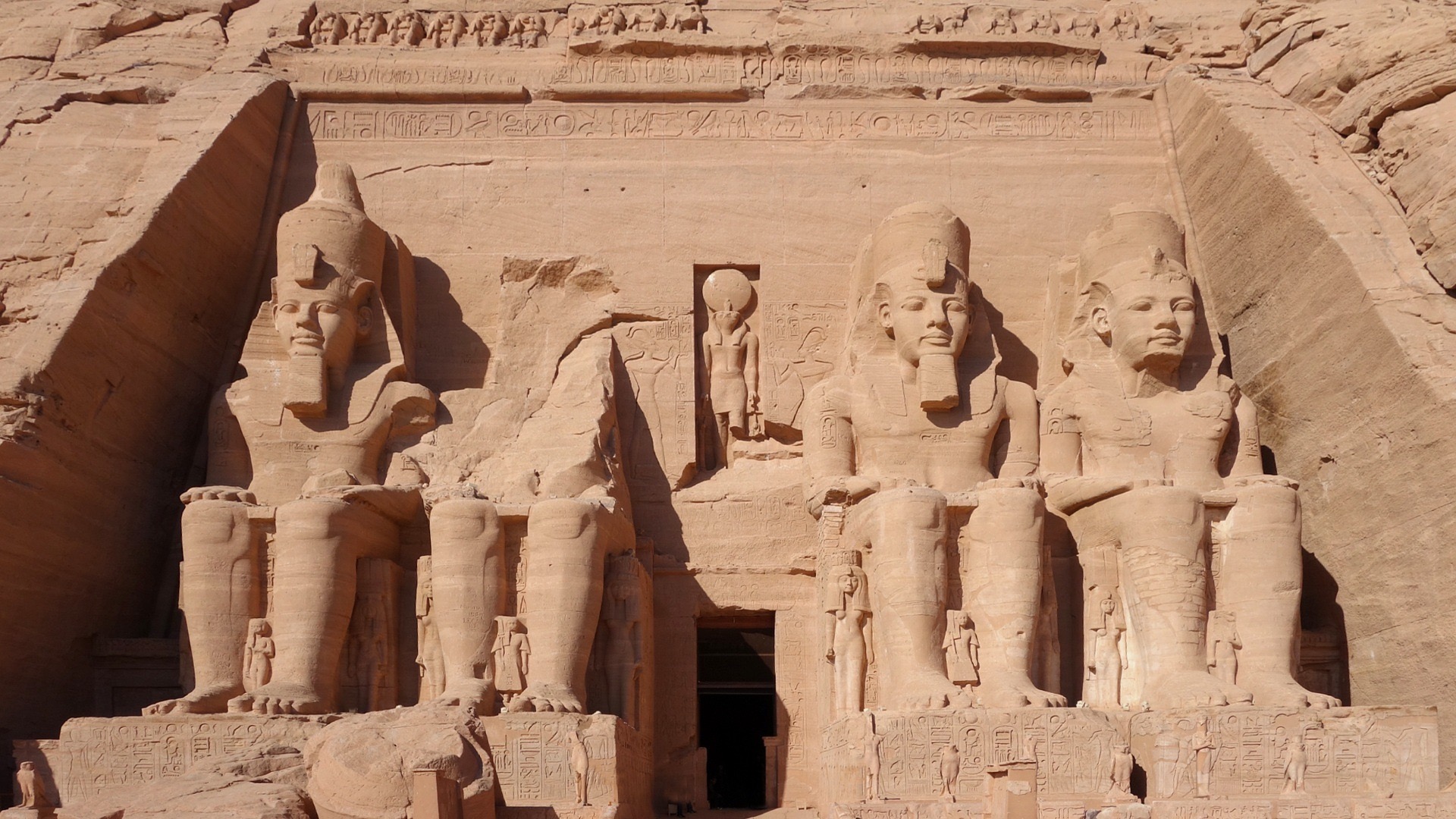
Ramesses II's colossal masterpiece - Egypt's most spectacular temple complex

Abu Simbel, located in far southern Egypt near the Sudanese border, is home to two massive rock-cut temples built by Ramesses II (c. 1264 BCE). The Great Temple features four colossal 20-meter seated statues of Ramesses carved directly into the mountainside - one of ancient Egypt's most iconic and photographed monuments.
In one of history's greatest engineering feats, UNESCO relocated the entire temple complex 65 meters higher and 200 meters back from the rising waters of Lake Nasser (1964-1968) when the Aswan High Dam was built. Over 2,000 workers cut the temples into 1,036 blocks and meticulously reassembled them. Despite modern technology, engineers couldn't perfectly recreate the solar alignment that illuminates the inner sanctuary twice yearly.
Facade: Four colossal 20m (66 ft) seated statues of Ramesses II
Purpose: Intimidate Nubian neighbors, deify Ramesses
Interior: 63m deep into mountain, pillared halls, inner sanctuary
Carvings: Battle of Kadesh reliefs, gods, prisoners
Details: Eight standing Ramesses statues inside as Osiris
Scale: Absolutely breathtaking in person
Dates: February 22 & October 22 (originally Feb 21 & Oct 21)
Event: Sunrise sunlight penetrates 63m to illuminate sanctuary statues
Illuminated: Ramesses, Ra-Horakhty, Amun (Ptah in darkness)
Originally: Ramesses' birthday & coronation dates
Since Relocation: One day off due to modern repositioning
Experience: Thousands gather, lottery system for temple entry
Dedicated to: Queen Nefertari & goddess Hathor
Facade: Six 10m colossal statues (4 Ramesses, 2 Nefertari)
Unique: Only Egyptian temple where queen equals pharaoh in size
Love: Ramesses' tribute to his favorite wife
Interior: Beautifully decorated pillared hall
Inscription: "She for whom the sun shines"
Why: Save temples from Lake Nasser flooding (Aswan Dam)
When: 1964-1968
Method: Cut into 1,036 blocks (up to 30 tons each)
Moved: 65m higher, 200m back from original location
Cost: $40 million (1960s), 50 countries contributed
Achievement: Greatest archaeological rescue operation ever
Subject: Ramesses II vs Hittites (c. 1274 BCE)
Location: Great Temple north wall
Detail: Extensive battle scenes, chariots, siege
Propaganda: Ramesses depicted as heroic victor
Reality: Probably stalemate, but impressive art!
Scale: One of ancient Egypt's largest historical narratives
Entry Fee: EGP 500 ($16 USD)
Hours: 6 AM - 5 PM (6 PM in summer)
Photography: Allowed outside, prohibited inside sanctuary
Time Needed: 1.5-2 hours to see both temples
Facilities: Visitor center, cafe, souvenir shops, toilets
Crowds: Busiest 8-11 AM when tour buses arrive
Schedule: Evening shows (times vary by season)
Cost: EGP 400-500 ($13-16 USD)
Experience: Temples illuminated, history narrated
Duration: 45-60 minutes
Languages: Multiple language shows available
Worth: Excellent if staying overnight in Abu Simbel
Option: Multi-day luxury cruises Aswan to Abu Simbel
Duration: 3-4 nights
Stops: Abu Simbel, Kalabsha, Amada, other Nubian temples
Style: Small luxury ships (40-100 passengers)
Cost: $1,000-2,500 depending on ship/season
Advantage: Visit temples with almost no other tourists
Nearby: Kalabsha, Beit el-Wali, Wadi es-Sebua
Access: Lake Nasser cruise or special tours
Status: All relocated to save from flooding
Visitor Numbers: Fraction of Abu Simbel crowds
For: Temple enthusiasts, cruise passengers
Note: Less spectacular but interesting
Abu Simbel is currently safe for tourists to visit. While the site's location near the Sudanese border historically raised security concerns in the past, the Egyptian government has made substantial improvements to ensure visitor safety in recent years. Today, Abu Simbel welcomes hundreds of thousands of international visitors annually without incident.
Security has dramatically improved through:
All tourist vehicles traveling to Abu Simbel participate in an organized convoy system, a security measure that has been in place for years. Tourist buses and private vehicles depart together from Aswan in the early morning hours (typically 4 AM and sometimes an 11 AM convoy), traveling as a group with security escort along the highway.
What this means for you:
It's important to acknowledge that in the past (primarily 1990s-early 2000s), Egypt's southern regions near the Sudanese border experienced isolated security incidents. However, these events led to comprehensive security improvements that have made the region far safer today. No significant tourist-related security incidents have been reported in the Abu Simbel area in recent years.
✓ Abu Simbel is safe to visit when you take standard travel precautions. Book with reputable operators, follow the convoy system, stay with your group, and respect local guidelines. Millions of tourists have visited Abu Simbel safely in recent years, and with proper planning, your visit will be both safe and unforgettable. The Egyptian government prioritizes tourist safety, especially at UNESCO World Heritage sites like Abu Simbel.
Stand before the colossal Abu Simbel - one of humanity's greatest monuments!